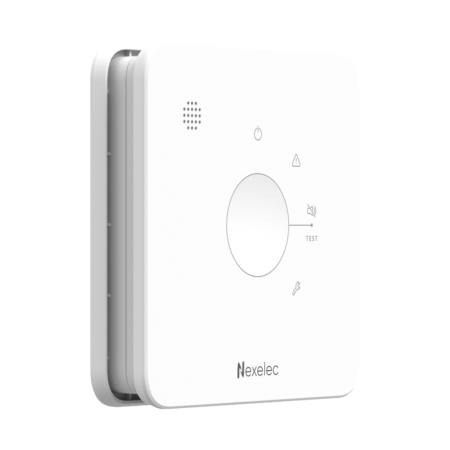-

SECURE
CO alarm. 10-year battery
-

Design
Facilitates acceptance of the detector by residents
-

10-year battery
Sealed and welded lithium battery
-

Digital detector logbook
QR Code + application for monitoring installation and maintenance of a fleet of detectors
-
-

SECURE+
CO alarm. 10-year battery. NFC chip
-

10-year battery
Sealed and welded lithium battery
-

Digital detector logbook
QR Code + application for monitoring installation and maintenance of a fleet of detectors
-

Electronic maintenance certificate
After each maintenance operation, a unique certificate is stored in the detector’s secure NFC chip
-
-

AIR
Connected CO alarm. 10-year battery
-

Connected
Remote maintenance without entering the home
-

Interconnection
Up to 25 wirelessly interconnected accessories
-

Design
Facilitates acceptance of the detector by residents
-
-
AIR+
Connected CO alarm. 10-year battery. Temperature/Humidity
-

Connected
Remote maintenance without entering the home
-

Interconnection
Up to 25 wirelessly interconnected accessories
-
Temperature / Humidity
Measures home environment parameters
-
Vigilance and Safety: carbon monoxide detectors in homes
The installation of carbon monoxide detectors in homes is crucial to safety. In fact, these devices are specially designed to continuously monitor the presence of carbon monoxide, an odorless and deadly gas that can be emitted during the combustion of various fuels.
When CO levels reach a dangerous threshold, the detectors emit an audible alarm. This alerts occupants to potential danger. This rapid reaction allows residents to take immediate action, such as ventilating the space or calling the emergency services, to avoid CO poisoning. Carbon monoxide alarms are often recommended, or even regulated, in many regions because of the potential dangers they help to prevent.
Carbon monoxide (CO) is a colorless, odorless and tasteless gas that is extremely hazardous to human health. It is produced by the incomplete combustion of fuels such as natural gas, coal, oil, wood and other combustibles. Every second counts to warn occupants and enable them to react quickly. Our carbon monoxide detectors are designed to operate optimally for 10 years. They react quickly to the slightest indication of danger.

Frequently Asked Questions
Our experts answer your questions
The carbon monoxide detector (DAACO) can quickly detect high concentrations of this gas in the air and warn occupants of a room so they can take appropriate action. This gas is odorless, invisible and toxic: inhaling CO can trigger headaches, fatigue, nausea and vomiting, and can even be fatal.
Carbon monoxide emissions
The source of the CO may come from :
- Oil, coal and gas heating equipment…
- Wood stoves
- Gas and fire boilers
- Tobacco smoke
- Barbecues
- Gas appliances such as stove, oven, refrigerator…
WARNING: for your own safety, do not disable your detector if it is operating correctly!
To switch off a sealed-battery detector, simply take a paper clip, insert it into the square hole at the back of the product, and pull slightly to raise the switch. If the detector has a changeable battery, simply remove the battery to switch the product off.
Please wait at least 20 seconds before switching the detector back on.
The detector can emit various visual (LED flashing) and/or audible (beep) signals:
- Normal operation: one green/minute LED flash
- Audible alarm mode: one red LED flash/second + one beep/second
- Audible alarm pause mode: one red LED flash/second
- Low battery: one flashing orange LED + one beep/minute
- Malfunction: one green LED flash/minute + two orange LED flashes/minute + two beeps/minute
- End of detector life: one green LED flash/minute + three orange LED flashes/minute + three beeps/ minute
- Test mode: Green and orange LEDs steady + red LED flashing + beeps during test
1,000+ customers
Local authorities, landlords, and businesses














